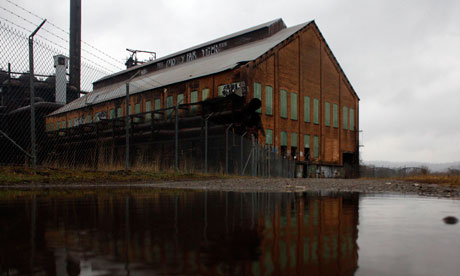Nolan's choice of locations also returns him to the very region of America where the movies began, just at the moment when many critics believe that studio cinema has reached a dead end. Mark Harris, in his GQ article The Day the Movies Died, portrays Nolan as a last great hope for studio film-making, which for Harris has reached "an all-time low". The Nation's Stuart Klawans, meanwhile, writes that "movies have lapsed into a semi-historical, niche-market status, like … easel paintings." If Nolan's career is meant to save studio pictures, it's an irony of movie history that he'd continue doing it in this area. Among the first permanent structures established as a moving picture house was Harry Davis's 1905 Nickelodeon theatre in Pittsburgh.The Warner brothers themselves, who founded the conglomerate now producing Nolan's film, grew up just across the state line in nearby Youngstown, Ohio (its "beautiful sky of soot" immortalised by Bruce Springsteen). They opened their first cinema in 1906, the Cascade Movie Palace, in New Castle, Pennsylvania. The Cascade – the cinema was located in the Knox building on South Mill Street – seated 99 and offered three movies for a nickel. Among the more legendary stories about the place presented by the Pennsylvania Historical and Museum Commission is that the Warner brothers apparently borrowed chairs from a local funeral home, which meant that they couldn't run their pictures when someone in town died. The Warners moved on to found their first film distribution company, the Duquesne Amusement and Supply Company, in Pittsburgh, in 1907.
There are more contemporary movie milestones in the article, that touch on the Rust Belt Chic attraction:
Underneath the gritty charm depicted in productions such as Wonder Boys, Flashdance, and the American version of Queer as Folk, there's also the lurking fear contained in the work of the city's best-known director, George A Romero, whose locally shot films include Night of the Living Dead and Martin, about a Pittsburgh-area grocery bag boy convinced that he is a vampire.
Yes, "gritty charm" ...

Think of this photo as an aesthetic test. Do you see beauty? Pittsburgh is also striking in more conventional ways (e.g. the dramatic physical geography). But I expect that most people don't appreciate the postindustrial pathos. I have mixed emotions about the image. I'm also deeply attached to this landscape. I react to the urban forms of Portland and Seattle like I would a suburb: Sterile and superficial.
I understand why so many people move to the cities of the Pacific Northwest. I get the allure. However, attitudes are changing. Detroit is cool:
Photographer Garrett MacLean relocated here from San Francisco in 2007 and cofounded the Yes Farm with two fellow transplants -- a cooperative helping stabilize a tattered east side neighborhood."When I moved here, nine out of 10 people who live here looked at me as if I was crazy," said MacLean, 33. "That's changed completely. When people move here now there's no longer any stigma."Photographer PD Rearick, 32, a recent graduate of the Cranbrook Academy of Art, started a local business serving the photo needs of artists."I can be an entrepreneur and take a risk without having to bear the consequences of a bigger city," said Rearick.
The Creative Class isn't moving to Detroit or Pittsburgh because of a turnaround in tolerance, talent, and technology. People are migrating to shrinking cities in search of Rust Belt Chic, the antithesis of the emerald boomtowns. They are looking for authenticity and an urban frontier. They identify with Anthony Bourdain, not Richard Florida.
We need to update our policy playbooks and rethink what we know about talent migration.
No comments:
Post a Comment